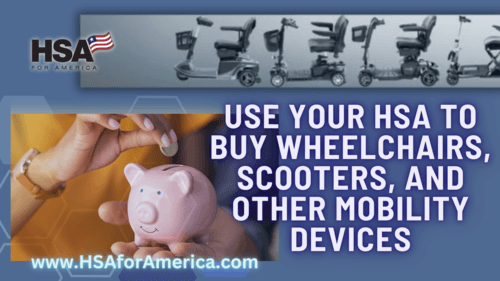There are lots of medical conditions that can affect your mobility.

Musculoskeletal disorders, such as arthritis, osteoporosis, and fractures, strokes, MS, Parkinson’s, spinal injuries, COPD, cancers, and severe vision loss can also make independent mobility difficult or impossible without mobility or other assistive devices.
Your doctor may recommend the use of an assistive device like a wheelchair or power scooter to help.
But these powered mobility devices can be costly!
Prices for electric scooters range from $1,000 to $5,000, while specialized electric wheelchairs may cost up to $15,000 or more!
Usually, but not always, medical insurance will cover part of the cost. But you could still have significant deductibles or co-pays. Or your insurance company may just pay for a manual wheelchair, leaving you responsible to pay the extra costs of a motorized device.
That’s where your health savings account comes in: you can use your HSA to pay out-of-pocket costs related to acquiring your electric wheelchair, scooter, or other assistive device.
HSAs and Eligible Expenses
A Health Savings Account (HSA) is a special savings account for qualified medical expenses.
Contributions to the HSA are tax-deductible, growth is tax-deferred, and withdrawals for approved medical costs are tax-free. The maximum amount that can be contributed to an HSA account in 2024 is $4,150 for an individual or $8,300 for a family. Whatever you don’t spend in a year rolls over to the next year.
HSAs can only be used to pay for qualified medical expenses described in IRS Publication 502.
That includes things you need to diagnose, treat, prevent, or alleviate a medical condition.
The good news: Wheelchairs, scooters, and other mobility devices are typically considered eligible medical expenses by the IRS. This means you can potentially use your HSA funds to pay for them without incurring taxes.
But there are some conditions and limitations you should be aware of.
For example, a basic wheelchair to improve daily living due to a medical condition qualifies. But a high-powered scooter used for recreational purposes might not.
Can I Use My HSA to Buy an Electric Wheelchair For My Spouse or Child?
HSAs allow you to use funds for eligible medical expenses for yourself, your spouse, and your eligible dependents.
This typically includes children, adopted children, stepchildren, and sometimes even parents or other qualifying relatives as defined by the IRS.
Compare Pricing on the Best HSA Plans Available
HSA Spending Limits
There is no specific maximum amount that can be spent on a mobility device using an HSA. You are free to use whatever is available in your account.
You can use your HSA funds for purchases even after you’re retired!
Learn More: What Is an HSA Qualified Expense?
The Advantages of Using Your HSA
Using HSA funds to pay for a wheelchair, scooter, or other mobility device saves money in taxes.
First, since HSAs allow contributions of pre-tax dollars, you’ll pay less in taxes upfront. You can then use these funds tax-free to cover qualified medical expenses.
Using tax free dollars to be pay for your wheelchairs or other assistive devices can amount to a discount of 10 to 46 percent, depending on your tax bracket and jurisdiction.
How It Works
- Contributions to an HSA are tax-deductible, and the funds can be withdrawn tax-free when used for qualified medical expenses, including mobility devices. This provides significant tax savings compared to paying out-of-pocket with after-tax dollars.
- Wheelchairs, scooters, and other mobility aids are considered qualified medical expenses and are eligible for reimbursement from an HSA. This includes both purchase costs and maintenance/repair expenses.
- Mobility devices can be expensive. Using HSA funds can help offset these costs, making them more affordable for individuals with high deductible health plans.
- HSA funds can be easily accessed and used to directly purchase eligible mobility devices.
- Unused HSA funds roll over from year to year, allowing you to save and accumulate funds for future medical expenses, including mobility device replacements or upgrades. Any funds you don’t need for medical expenses become available penalty free to supplement your retirement savings once you turn 65.
- If the cost of the mobility device exceeds the available HSA balance, you can split the payment, using the HSA funds for part of the cost and paying the remainder out-of-pocket.
Using an HSA to purchase a wheelchair, scooter, or mobility device provides tax advantages, cost savings, and convenience, making it a great option!
* Important Note: If you have health insurance coverage for the mobility device, you may need to submit claims first before using HSA funds for any remaining out-of-pocket costs.
Learn More: Understanding Your HSA Tax Forms
How to Get Your Device
To use a Health Savings Account (HSA) to purchase a wheelchair, scooter, or other mobility device, there are a few steps you’ll have to follow.
Getting Started
- Talk With Your Doctor – Get a written prescription or letter of medical necessity from your healthcare provider stating the need for the mobility device. This documentation may be required by your HSA administrator for reimbursement.
- Confirm Eligibility – Verify that the specific mobility device you need is an eligible expense under your HSA plan. Wheelchairs, scooters, and other mobility aids are generally eligible, but it’s best to check with your HSA administrator or review the plan documents.
- Research Products – Explore different mobility device options that meet your needs and fit within your HSA budget. Look for products marked as “FSA/HSA eligible” from reputable retailers or manufacturers.
Make the Purchase
- Check Your HSA Balance – Make sure you have sufficient funds in your HSA to cover the cost of the mobility device. If not, you may need to make additional contributions or consider financing options.
- Buy the Device – When ready to make the purchase, use your HSA debit card or HSA funds to pay for the mobility device directly. Some retailers may allow splitting the payment between your HSA card and another payment method if the cost exceeds your HSA balance.
- Save the Receipts – Keep all receipts, invoices, and documentation related to the purchase, as you may need to submit them for reimbursement or to document your expenses.
How To Submit Your Claim
To submit a claim for a mobility device like a wheelchair or scooter to your HSA, you typically need to provide the following documentation:
- Prescription or Letter of Medical Necessity – You must obtain a written prescription or letter from your healthcare provider stating the medical necessity for the mobility device.
- Itemized Receipt or Invoice – You need to submit an itemized receipt or invoice that clearly shows the purchase details of the mobility device, including the date of purchase, description of the item, and the total cost.
- Claim Form – Most HSA administrators require you to complete and submit a claim form specifically for reimbursement of eligible expenses. This form may need to be signed by you or your healthcare provider.
- Proof of Payment – Depending on your HSA plan, you may need to provide proof of payment, such as a credit card statement or canceled check, to verify that you paid for the mobility device out-of-pocket.
- Additional Information – Your HSA administrator may request additional information or documentation, such as medical records or a detailed description of the mobility device and its intended use, to verify the eligibility of the expense.
Providing complete and accurate documentation will help ensure a smooth reimbursement process.
Enjoy the Benefits
Once your claim is approved, your HSA administrator will reimburse you for the eligible expenses, either by direct deposit to your HSA account or by mailing you a reimbursement check.
By following this process and providing the necessary documentation, you can use your HSA funds tax-free to cover the costs of eligible mobility devices.
You can also use HSA dollars to put in a wheelchair ramp for your house, widen doors, put in an elevator, or any other medically necessary remodeling.
This provides significant savings compared to paying out-of-pocket!
Compare Pricing on the Best HealthShare Plans Available
Get Moving!
Impaired mobility is a common concern for many adults, especially as they age.
Issues such as muscle weakness, balance problems, pain, or visual impairments can greatly impact your quality of life. These physical limitations often become more pronounced with age, so it’s important to think ahead and be prepared.
Power wheelchairs, scooters, and other mobility devices are designed to help you move around better and maintain independence within your home and community.
Obtaining the right device is important!
Conclusion
HSAs can be used to cover or offset the costs of a mobility device. They can also be used for maintenance, repairs, and accessories related to the mobility device, providing ongoing cost savings. The unused funds roll over from year to year, allowing you to save for future medical expenses or mobility device replacements.
For more information on how to minimize your out-of-pocket costs for mobility devices and to understand better how to use your HSA effectively, contact a Personal Benefits Manager. They can answer any questions you may have and guide you through the process.
For Further Reading: Health Savings Account FAQs | Can I Use an HSA to Pay For Counseling or Therapy? | Health Savings Accounts Are Built for Alternative Therapies



